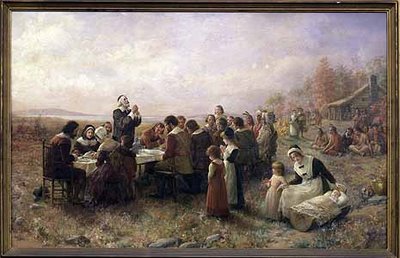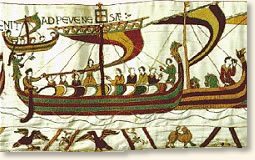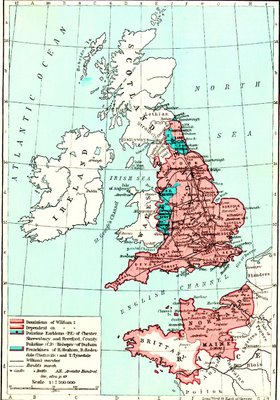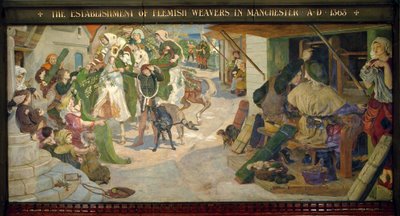The Flemish Influence on the American Pilgrims - Part 1
From the desk of David Baeckelandt on Thu, 2009-07-30 19:10

"There is thus strong ground for the assertion of Mr. Griffis, that many Americans who boast of their “unmixed English stock” are descended from Dutch or Flemish ancestors who first saw England in the Duke of Alva’s time. One hardly sees how it could be otherwise. In the days of Charles I. a considerable part of the rank and file of Puritans were children and grandchildren of Netherlanders, and of these surely many must have been included among the 20,000 who came to New England between 1629 and 1640."
-- John Fiske, The Dutch and Quaker Colonies in Americap.53
The Flemish: a Source for the Pilgrims’ Thought and Practices?
Most Americans view the Thanksgiving holiday, held on the fourth Thursday of the month of November, as the quintessential American holiday. The story, of course, celebrates not only the Founding Myth of America – oppressed English Separatists abandon the Old World to create a utopia in the New World – but includes elements that appeal to almost everyone. Religious conservatives stress the explicit thanks to God; secularists look at it as a time of familial togetherness in lieu of Christmas. Regardless of creed and ethnicity, virtually all Americans – with the notable exception of some percent of the Native American community – celebrate Thanksgiving in the United States. As one modern Pilgrim historian idealizes:
“The historical fact that the Pilgrims’ First Thanksgiving saw them sitting down with Native Americans in peace and friendship provides an ideal icon…for today’s multi-cultural society.”[i]
At the beginning of every retelling of the Pilgrim’s saga in schools across America is the explanation for their departure to America after spending 12 years (1609s-1620) in the city of Leiden (spelled “Leyden” for American audiences) in the Netherlands. In school textbooks the story goes something like this: after several years’ shepherding by the Reverend John Robinson of Norwich, and without any apparent connection, the Pilgrims move from Scrooby in East Anglia to Holland hoping for and receiving religious freedom to practice their syncretic blend of Anabaptism and Calvinism. They settle down, some become citizens, many marry, and most raise families and become an integral part of the community. But they grow restless and are unhappy with their children speaking Dutch, forgetting English and otherwise adapting to their surroundings. So they resolve to leave Holland and set up a utopia in America. They land in America, and after a year filled with hardship alleviated by generous Amerindians, give thanks for their deliverance with the first –seemingly spontaneous – Thanksgiving feast.

As children we accept this story at face value. But as adults, with the benchmark of our own life experiences to set against the tale, it appears that key elements have either been lost in the retelling or intentionally obscured. For example, where did the pilgrims pick up their Calvinist beliefs? Why did they maintain them when the Church of England and the monarchy (Queen Elizabeth I for the half-century before1603/King James I afterwards) viewed religious dissent as treason? Finally – and, from my viewpoint, most importantly – is there a Flemish element to this story?
In fact of course, there is a strong Flemish connection. This connection comes from not only the daily contacts that key figures in the Pilgrim hierarchy had with Flemish migrants to England and in Leyden, but also seminal events that were imprinted on their psyche, collectively and individually. However, these influences are tempered and offset by the biases and fears of the unstable environment they lived in. In this essay I will attempt to explain the setting and trace the paths that lead from America’s Founding Fathers back to Flanders Fields.
The Pilgrims’ Story
The most complete retelling of the adventures and tribulations of the Pilgrims’ origins and journey were written by one of the leaders of the colony, William Bradford, in 1650 under the title Of Plimouth Plantation. But as one of the most prominent of modern historians has written:
“Bradford was disingenuous at times. He was not above politic distortion of facts, and did not hesitate to suppress whole chapters in the history of his brethren…More than once he misrepresented the sequence of events, cleverly transposing cause and effect.”[ii]
Important elements of the Pilgrims’ story are of course accurate. In recent decades as shibboleths have been shattered in other national myths, some parts of the Pilgrim odyssey have been subject to serious scrutiny. However, although a number of serious historians have attempted to brush aside the cobwebs of historical myth and time to clear up the romanticist picture painted by our 19th century predecessors, no one has felt a need to explain or clarify the Flemish influence on the Puritans, the Pilgrims and the First Thanksgiving. To do so we must examine the place and the times.

Medieval Flemish Colonists in England, Ireland, Wales and Scotland
A Flemish connection to the British Isles of course did not surface overnight. Flemings have been recorded as resident in England at least since the so-called “Norman” invasion of 1066[iii]. The Flemings in fact were the key component[iv] that swung the tide in favor[v] of William the Conqueror. Flemings immediately were involved in subduing the British Isles for William and were awarded fiefs – especially in Scotland where they adopted names such as Stirling, Graham and Malet. Other Flemish nobles who assumed Scottish fiefs along with Scottish surnames included Bruce, Bethune, Buchan, Lindsay, Lyle, and Stewart[vi]. Records of trade between Flanders and England are recorded to as early as 1066[vii]. Those strong, early trade relations were manifested in the first recorded example of two countries signing a treaty recognizing their respective flags[viii].

Successive waves of Flemings arrived in England at the invitation of English monarchs in every subsequent century. William the Conqueror’s half-Flemish (through his mother, the Bruggeling Matilda of Flanders) son, Henry I, possibly in successive waves beginning as early as 1106 (due to flooding)[ix] and continuing as late as 1127. Starting a precedent that would frequently be copied by his successors, Henry enticed and incented a large colony of Flemings to occupy Mailros in England and later to Haverford in Pembrokeshire in southwestern Wales. This area retained a distinctive, Flemish-influenced dialect up until modern times. Henry I's son Stephen I added more Flemings to the realm – some as builders in Carlisle and others as mercenaries under a William of Ypres[x] – although Henry II saw them as a threat and banished them to their ‘cousins’ in Wales. The queen of Wales, Nest ferch-Rhys, even had a child by a Flemish settler there in the 1100s. Her progenity are claimed to include “half of Wales”[xi].

Further Flemish immigration came as early as 1169[xii] in response to an appeal to the English by one of two warring Irish kings. But also later, in the 1200s, most notably as mercenaries in Ireland[xiii]. These men carved out a fief on the eastern coast of Ireland, near Waterford, in the baronies called Forth and Bargy, almost on a direct line across from Pembroke in Wales. The Flemish settlers kept themselves separate to the extent that residents not only continued to use a Flemish-derived dialect[xiv] at least until the early 19th century[xv] but also supplied many emigrants, en masse, to America in the 1840s. Common names from the Forth and Bargy region with Flemish ancestry include Gifford, Stafford, Jenkins and Seys.

Better known and more often cited are the well-announced draws of Flemish weavers that Edward III resettled in Bristol, Manchester as well as the traditional Flemish refuge in East Anglia beginning in the 1330s. In each of these venues the new immigrants not only added to England’s burgeoning cloth making but set the stage for a boom in trade. For example, the Flemish contribution pushed Bristol into the forefront of British overseas trade from the late 14th century well up to the early 17th century (and played a role in the early voyages to the New World both before and after Columbus – but that is another story).

In fact the Flemish were so prominent a presence throughout the British Isles that William Caxton, who himself spoke Flemish after a long sojourn in Brugge (1441-1476; where he produced the first book printed in English), claimed that the Flemish “formed the seventh race in the island” [xvi]. Caxton later added to this.
“The Flemings living in West Wales have now all become like Englishmen because they live alongside English people: they are mighty, fierce fighters and the greatest enemies the Welsh have; they engage in trading, especially the wool-trade; they are very ready to risk adventure and danger by sea and by land for the sake of great profit; they are willing sometimes to plough the land; and sometimes they engage in deeds of arms as the occasion demands…They discern reliably what is done in distant lands, signs of peace or war, the state of the realm…”[xvii]

Part II will discuss the massive Flemish migration to England in the 16th century and the religious, advisory as well as intellectual and financial contributions the Flemish made to America's Pilgrim Founding Fathers.
Endnotes
[i] Jeremy Dupertius Bangs in “Thanksgiving Day – A Dutch Contribution to American Culture?” in New England Ancestors Holiday 2000, p.38
[ii] George F. Willison in Saints and Strangers (New York: Time Life Books, 1981) p.4
[iii] Elisabeth van Houts, "The Norman Conquest Through European Eyes" reprinted from The English Historical Review, Sep 1995 v110 n438 p832(22) http://www.geocities.com/athens/aegean/3532/1066Euro.htm
[iv] http://www.battle1066.com/wforce1.shtml
[v] http://72.232.229.42/thumb/9/99/Battle_of_hastings1.svg/350px-Battle_of_hastings1.svg.png
[vi] “The Rise of the Flemish Families in Scotland” by Annette Hardie - Stoffelen http://www.amg1.net/scotland/flemfam.htm
[vii] See “De Vlaamse handel op Engeland voor het Engels-Vlaams Konflikt van 1270-1274” by C. Wyffels in Bijdragen voor de Geschiednis der Nederlanden Deel XVII, 1963, No.3, pp.205-213.
[viii] “The first flags identifying nationality were used at sea. The oldest international legal obligation on record for ships to display flags as identification was agreed by King Edward I of England and Guy, Count of Flanders, in 1297. It explicitly compelled merchant ships to ‘carry in their ensigns or flags the arms of their own ports certifying their belonging to said ports.’” The World Encyclopedia of Flags by Alfred Znamierowski (London: Hermes House, 2006) p.44
[ix] For a brief overview see the BBC posting at http://www.bbc.co.uk/wales/history/sites/themes/society/migration_flanders.shtml . The detailed and extensive study of the Flemish contribution can be culled from Dwaard A. Freeman, The History of the Norman Conquest of England, Its Causes and Its Results, (Oxford: Clarendon Press, 1876), p.855
http://books.google.com/books?id=xFc0AAAAIAAJ&pg=PA855&vq=flemish&dq=%22flemish+settlements%22&source=gbs_search_s
[x] Ibid p. 276 http://books.google.com/books?id=xFc0AAAAIAAJ&pg=PA276&vq=flemish&dq=%22flemish+settlements%22&source=gbs_search_s
[xi] http://www.guardian.co.uk/commentisfree/2007/dec/21/britishidentity.uk This article appeared in the Guardian on Friday December 21 2007 on p34 of the Comment & debate section. It was last updated at 15:15 on February 09 2008.
[xii] The Atlantis By Dublin University College, Published by Longman, Brown, Green, Longmans, and Roberts, 1858 p. 236 http://books.google.com/books?id=fusAAAAAYAAJ&pg=PA236&vq=flemish&dq=flemish,+forth&source=gbs_search_s
[xiii] "Ireland History: The Normans" http://www.irelandhistory.org/irish-history/normans/the-coming-of-the-normans/the-normans.html
[xiv] "Origins of the Dialect of the Baronies of Forth and Bargy" http://www.forthandbargy.org/research_hist.htm
[xv] Studies in Middle English Linguistics by Jacek Fisiak (New York: Walter de Gruyter, 1997), p.181 http://books.google.com/books?id=RppwKv9Oh8EC&pg=PA181&vq=flemish&dq=flemish,+english,+linguistics&source=gbs_search_s&sig=ACfU3U2tFAn-BLwei7KHLSArZrc_efou_w
[xvi] Caxton: The Description of Britain by William Caxton; edited by Marie Collins (New York: Weidenfeld and Nicolson, 1988) p.109.
[xvii] Ibid p.114.Copyright 2008 by David Baeckelandt
This article was originally published on the "Flemish American" weblog.

The Moorish Spanish Portguese influence on Irish Americans
Submitted by Home Rule for England on Mon, 2009-08-03 19:56.
It is interesting to note that many Irish Americans are of mixed stock. Many English Presbyterians moved to Scotland and subsequently made the journey to Ireland as did many Scots.
Then we have the darker haired/skinned Irish who live mainly on the west coast of Ireland. They are descended from Spanish and Portuguese settlers. There is also a strong Moorish influence as Moorish settlers reached as far as Ireland.
Then of course the Spanish Armada was defeated by Sir Francis Drake and the English navy in 1588. A number of Spanish ships were wrecked on the Irish coastline while fleeing back to Spain. The sailors remained where they had landed.
So many Irish Americans are descended from Spanish,Portuguese,Moorish,Scottish and English ancestors!
@ Helian
Submitted by traveller on Fri, 2009-07-31 18:54.
I met in Texas 2 brothers who claimed to be true blood English.
One of them showed me their family bible. Their name was Driggs,but in the bible I found them to be of Flemish origin from the city of Gent and their original name was De Rijcke, which over the centuries became rewritten many times in bad handwriting. They arrived in the US in the 18th century.
Unmixed English Stock
Submitted by debendevan on Fri, 2009-07-31 18:51.
Helian - great points. I too have lived most of my 47 years in the U.S. and have never heard someone describe their background as of "unmixed English stock". But Fiske and Griffis were writing a century ago (Fiske, in the quote I cited, back in 1899) and it was indeed a different age and time. That said, the sentiments Fiske expressed - distaste at the simplistic genealogical myth perpetuated in US schools of our national origin - is one I share. If you attended schools in the US as a youngster you may recall the propagation of the official positon that England is the Mother Country and the Pilgrims were merely English ascetics who wanted nothing more than a quiet place to practice their faith. On multiple fronts this national myth is inaccurate. But my interest is in correctly crediting the Flemish component of their ethnic origins. My intent is to demonstrate the fact that the mixed DNA of our Pilgrim Fathers owes a great deal to Flemish Protestants. Hence the quote from the good Dr. Fiske. mvg, de bende van...
Unmixed 2
Submitted by KO on Fri, 2009-07-31 18:44.
@Helian. The Fiske book dates from 1899. WASP confidence was still at high tide, not yet having been suppressed to make room for the self-esteem of the Irish and other ethnic groups. I once heard a lecturer claim that Griffith's Birth of a Nation reflected anxiety caused by the flood of new immigrants from southern and eastern Europe.
Unmixed English Stock
Submitted by Helian on Fri, 2009-07-31 14:43.
I've lived in the US most of my life, and have never heard one of my fellow citizens boast of being of "unmixed English stock." Where does one find such creatures? On the other hand, I have read English essays attributing the nation's strength to its "mixed stock."